@CLSChen
2019-09-22T11:34:02.000000Z
字数 24793
阅读 1874
Java进阶
Java 编程
- 课本:Java语言程序设计与数据结构(进阶篇)
课本链接:https://pan.baidu.com/s/15VkXjOdqpfKSNd4sdI8t_A
提取码:66eq
第19章 泛型
Java泛型详解:https://www.cnblogs.com/coprince/p/8603492.html
- 泛型和可以参数化类型,这个能力使我们可以定义带泛型类型的类或方法或接口
<>,然后在调用它的时候用具体的类型来替换<>里的内容。
Generic<T> //泛型类T //泛型类型参数
- 泛型是从JDK1.5开始加入的,使用泛型可以将运行时错误转换为编译时错误,也就是说,错误仍然存在,比如将一个Date与字符串进行compareTo比较,原来是运行的时候报错,现在在编译器里就会指出这个错误。
使用泛型可以提前检测出错误
- 不使用泛型,在运行时出错。
List arrayList = new ArrayList();arrayList.add("aaaa");arrayList.add(100);for(int i = 0; i< arrayList.size();i++){String item = (String)arrayList.get(i);Log.d("泛型测试","item = " + item);}// 运行结果java.lang.ClassCastException: java.lang.Integer cannot be cast to java.lang.String在运行的时候检测出来,不可以将Integer类转换成String,报错。
- 使用泛型,编译出错。
List arrayList<String>= new ArrayList<>();arrayList.add("aaaa");arrayList.add(100);// 编辑器报错,不可以向其中添加Integer。
- 注意:泛型类型必须是引用类型而不能是基本类型,如
int是不可以的。
同样的,instanceof不能对确切的泛型类型使用。 - 我们可以使用
Integer。Java会自动将5包装为new Integer(5),这个过程称为自动装箱。
ArrayList<Integer> intList = new ArratList<>();intList.add(100);// 可以直接用100,而不用new Integer(100)
泛型使用[类型消除]
- 在
JDK1.5之前没有使用泛型的时候,输出列表内的元素需要强制类型转换,因为当时的ArrayList不知道其中存储的是什么类型的对象。
// 未给ArrayList声明对象类型ArrayList dates = new ArrayList();dates.add(new Date());// 因此要进行强制类型转换Date date1 = (Date)dates.get(0);
JDK1.5之后,ArrayList知道自己储存的是Date对象。
// 声明ArrayList泛型的对象为Date,ArrayList知道自己储存的是Date对象。ArrayList<Date> dates = new ArrayList<>();dates.add(new Date());// 可以直接读取Date date1 = dates.get(0);
但是,当编译结束后,Java处理器仍然将泛型转化为普通类型(类型消除),并在最后加一个强制类型转换。也就是说,最后都会回到第一种情况(笑)。泛型只在编译的时候有效果,不会进入到运行时段。
因此,泛型类型在逻辑上看以看成是多个不同的类型,实际上都是相同的基本类型。因此对其使用instanceof是错误的。我们创建两个泛型列表。
ArrayList<String> list1 = new ArrayList<>;ArrayList<Integer> list2 = new ArrayList<>;
- 尽管在编译时
ArrayList<String>和ArrayList<Integer>是两种类型,但是,运行时只有一个ArrayList类会被加载到JVM中。list1和list2都是ArrayList类的实例,因此,下面两条语句的执行结果都为true:
list1 instanceof ArrayList;list2 instanceof ArrayList;
- 然而这句表达式是错误的
list1 instanceof ArrayList<String>;
- 由于ArrayList并没有在JVM中存储为单独一个类,所以,使用它是毫无意义的。
- 因为这一点,对于如何使用泛型类型有一些限制,下面这些是错误的。
// 不能使用[泛型类型参数]创建对象和数组E test = new E();E[] testarray = new E[5];// 可以使用强制类型转换配合object类来做,但是仍然会有警告。E[] testarray = (E[])new object[5];---// 使用[泛型类]创建对象是可以的ArrayList<String> test = new ArrayList<String>;// 但是使用[泛型类]创建数组也是不允许的ArrayList<String>[] testarray = new ArrayList<String>[];// 同样也可以使用强制类型转换,但是也会有警告ArrayList<String>[] testarray = (ArrayList<String>[])new ArrayList<String>[];---// 静态方法和异常类不能是泛型的。
- 由于ArrayList并没有在JVM中存储为单独一个类,因此,虽然
Integer是Number的子类,但是ArrayList<Integer>不是ArrayList<Number>的子类,虽然同一种泛型可以对应多种类型,这几种类型可能还会有些子类父类的关系,但是不同的泛型类实例是不兼容的。 - 那么,我们就需要泛型通配符。
泛型通配符
泛型类的声明和构造方法
- 在定义类的时候只需要声明是泛型如
<T>,而创建类实例时需要指定对象类型如<String>,但是构造方法并不需要加,构造方法保持原样。
// 泛型类定义class Generic<T>{// 构造方法public Generic();}// 创造类实例new Generic<String>
泛型方法的声明
- 泛型类中定义了泛型(
<T>中的T),在很多方法中都会用到T,但是不是用到T的方法就是泛型方法,泛型方法有自己的定义。 - 泛型方法在
public和返回值之间加了个<T>,只有这样单独声明的方法才是泛型方法。泛型方法的泛型不收泛型类限制,可以向里面传入任何类型,而不只是类创建时声明的那个类型,泛型方法和泛型类是独立的。 - 正确的泛型定义
public static <T> void print(E[] list){};
- 泛型方法的基本用法和易错点
public class GenericTest {//这个类是个泛型类,在上面已经介绍过public class Generic<T>{private T key;public Generic(T key) {this.key = key;}//我想说的其实是这个,虽然在方法中使用了泛型,但是这并不是一个泛型方法。//这只是类中一个普通的成员方法,只不过他的返回值是在声明泛型类已经声明过的泛型。//所以在这个方法中才可以继续使用 T 这个泛型。public T getKey(){return key;}/*** 这才是一个真正的泛型方法。* 首先在public与返回值之间的<T>必不可少,这表明这是一个泛型方法,并且声明了一个泛型T* 这个T可以出现在这个泛型方法的任意位置.* 泛型的数量也可以为任意多个* 如:public <T,K> K showKeyName(Generic<T> container){* ...* }*/public <T> T showKeyName(Generic<T> container){System.out.println("container key :" + container.getKey());T test = container.getKey();return test;}/*** 这个方法是有问题的,编译器会为我们提示错误信息:"UnKnown class 'E' "* 虽然我们声明了<T>,也表明了这是一个可以处理泛型的类型的泛型方法。* 但是只声明了泛型类型T,并未声明泛型类型E,因此编译器并不知道该如何处理E这个类型。*/public <T> T showKeyName(Generic<E> container){...}/*** 这个方法也是有问题的,编译器会为我们提示错误信息:"UnKnown class 'T' "* 对于编译器来说T这个类型并未项目中声明过,因此编译也不知道该如何编译这个类。* 所以这也不是一个正确的泛型方法声明。*/public void showkey(T genericObj){}}
泛型方法不受类的限制
- 泛型方法一旦声明,即使未在类中声明的泛型,编译器也能识别。
- 普通的方法使用T就必须是泛型类中定义的T,但是泛型方法中的T可以为任意类型,E、K也一样,总之,泛型方法一旦声明,就与类独立。
public class GenericFruit {class Fruit{@Overridepublic String toString() {return "fruit";}}class Apple extends Fruit{@Overridepublic String toString() {return "apple";}}class Person{@Overridepublic String toString() {return "Person";}}class GenerateTest<T>{public void show_1(T t){System.out.println(t.toString());}//在泛型类中声明了一个泛型方法,使用泛型E,这种泛型E可以为任意类型。可以类型与T相同,也可以不同。//由于泛型方法在声明的时候会声明泛型<E>,因此即使在泛型类中并未声明泛型,编译器也能够正确识别泛型方法中识别的泛型。public <E> void show_3(E t){System.out.println(t.toString());}//在泛型类中声明了一个泛型方法,使用泛型T,注意这个T是一种全新的类型,可以与泛型类中声明的T不是同一种类型。public <T> void show_2(T t){System.out.println(t.toString());}}public static void main(String[] args) {Apple apple = new Apple();Person person = new Person();GenerateTest<Fruit> generateTest = new GenerateTest<Fruit>();//apple是Fruit的子类,所以这里可以generateTest.show_1(apple);//编译器会报错,因为泛型类型实参指定的是Fruit,而传入的实参类是Person//generateTest.show_1(person);//使用这两个方法都可以成功generateTest.show_2(apple);generateTest.show_2(person);//使用这两个方法也都可以成功generateTest.show_3(apple);generateTest.show_3(person);}}
静态方法直接声明为泛型方法
- 我们知道,静态方法无法访问实例方法,因为它不需要对象,所以需要新建对象才能确定的泛型类型T也无法使用。这时,如果静态方法有泛型需要的时候(引用的数据类型不确定),需要直接将静态方法声明为泛型方法。
public static <T> void print(T t){}// 注意static位置在<T>前
受限泛型类型
- 可以将泛型指定为另外一种类型的子类型。称为受限(Bounded)。
Public static <T extends Generic> void print(T t){}
- 非受限泛型类型
<E>等同于<E extends Object> - 注意:
为一个类定义泛型类型,需要将泛型类型放在类名之后,如Generic<E>
为一个方法定义类型,需要将泛型类型放在返回值之前,如<E> void max(E o1,E o2)
示例:对一个对象数组进行排序。
- 本例中的sort方法可以对任意实现了comparable接口的实例进行排序。
- 泛型类型定义为
<E extends Comparable<E>>,这有两个含义,一是它指定E为Comparable的接口实例,其次,它指定Comparable进行比较的元素是E类型的。
package chapter19;public class GenericSort {public static void main(String[] args) {// Create an Integer arrayInteger[] intArray = { new Integer(2), new Integer(4), new Integer(3) };// Create a Double arrayDouble[] doubleArray = { new Double(3.4), new Double(1.3), new Double(-22.1) };// Create a Character arrayCharacter[] charArray = { new Character('a'), new Character('J'), new Character('r') };// Create a String arrayString[] stringArray = { "Tom", "Susan", "Kim" };// Sort the arrayssort(intArray);sort(doubleArray);sort(charArray);sort(stringArray);// Display the sorted arraysSystem.out.print("Sorted Integer objects: ");printList(intArray);System.out.print("Sorted Double objects: ");printList(doubleArray);System.out.print("Sorted Character objects: ");printList(charArray);System.out.print("Sorted String objects: ");printList(stringArray);}/** Sort an array of comparable objects */● public static <E extends Comparable<E>> void sort(E[] list) {E currentMin;int currentMinIndex;for (int i = 0; i < list.length - 1; i++) {// Find the minimum in the list[i..list.length-1]currentMin = list[i];currentMinIndex = i;for (int j = i + 1; j < list.length; j++) {if (currentMin.compareTo(list[j]) > 0) {currentMin = list[j];currentMinIndex = j;}}// Swap list[i] with list[currentMinIndex] if necessary;if (currentMinIndex != i) {list[currentMinIndex] = list[i];list[i] = currentMin;}}}/** Print an array of objects */public static void printList(Object[] list) {for (int i = 0; i < list.length; i++)System.out.print(list[i] + " ");System.out.println();}}
通配泛型
- 可以使用非受限通配,受限通配,或者下限通配来对一个泛型类型指定范围。
// 非受限通配<?>// 受限通配<? extends SuperClass>// 下限通配<? super T>
第20章 线性表List、栈Stack、队列Queue和优先队列Priority Queue
- 定义一个数据结构的本质就是定义一个类。数据结构类应该使用数据域存储数据,并提供方法支持查找、插入、删除等操作。
创建一个数据结构就是创建这个类的一个实例。
Java中的两种容器
1.存储相同元素的合集collection
2.存储键值对的映射表map- 本章讨论合集。
接口->抽象类->具体类
- 接口定义了一个框架,抽象类提供接口的部分实现,具体类用具体的数据结构实现这个接口。通用的特性在接口中实现,越往下分类越细,也就越具体。
add()只能在子类里实现,因为它涉及到具体的类型。 - 接口里的方法数量是最少的,但它的方法在它的所有子类里都能用,它就像在金字塔的塔尖。
- 如:
List接口,AbstractList抽象类,ArrayList类。 用户可以简单的定义一个具体类继承一个抽象类,这样就不用实现接口的所有方法。这些抽象类被称为便利抽象类。
所有的合集继承于
Collection接口,它提供了往合集中添加和删除元素的方法,如add,remove,retain(并、差、交)和相应的addAll,removeAll,retainAll,前者操纵单个对象,后者操纵整个合集。
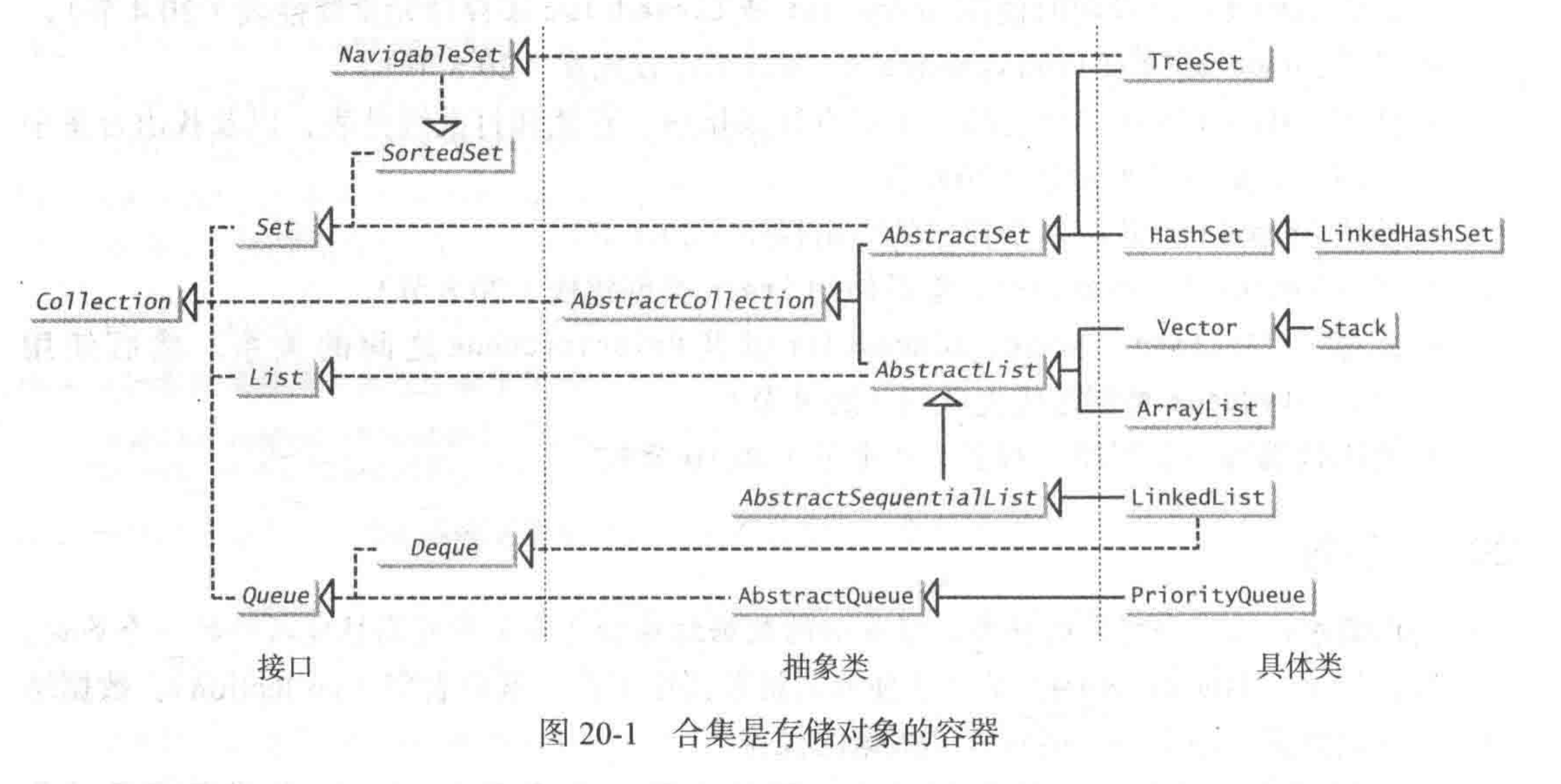
AbstractCollection实现了除add()和iterator()(迭代器)这种以外的所有方法。
迭代器 Iterator<E>
// 创建一个列表alistArrayList<String> alist = new ArrayList<String>();alist.add("new york")alist.add("new york2")// 为alist生成一个迭代器Iterator<String> alistRator = alist.iterator();// 使用迭代器来访问列表while(alistRator.hasNext()){System.out.println("iterator.next().toUpperCase()" + " ");}//输出:new york new york2
- 其实,使用foreach循环也可以实现,并且不需要用到迭代器。
- foreach可以用于Iterator的任何实例。
ArrayList<String> alist = new ArrayList<String>();alist.add("new york")alist.add("new york2")for(String a:alist){System.out.println("a.toUpperCase()" + " ");}
Collection接口与Iterator接口

线性表 List接口
- 两个具体类:
ArrayList和LinkedList - 如果一个合集不需要改变数据,那么
数组是最优方案,如果需要改变长度,那么ArrayList是最优方案,如果还想在表头修改数据,那么LinkedList是最优方案。(注意:ArrayList也能在表头修改,但是效率会低一些,因为所有元素需要后移) - List接口中的通用方法
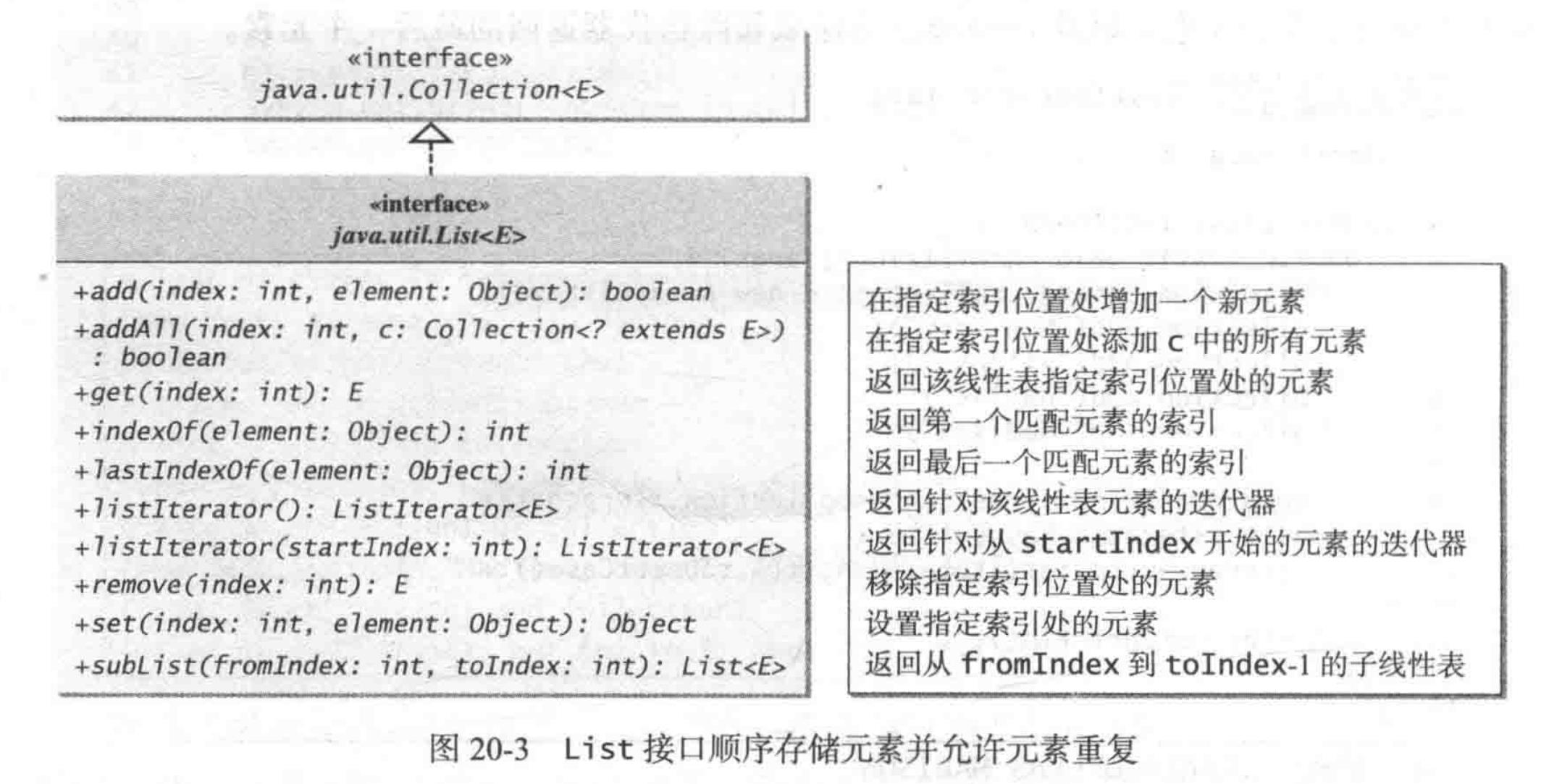
- 注意:List接口中有一个
listIterator()方法和listIterator(startIndex)方法,它们都继承了Iterator接口并拓展它。它们会返回一个针对该列表元素的迭代器,并且支持双向遍历。
数组线性表类ArrayList和链表类LinkedList
ArrayList的动态创建:
ArrayList用数组存储元素。它的内部存在一个数组数据域,数组是无法改变大小的,但是ArrayList可以,这是怎么做到的呢?ArrayList在检测到超过最大长度时,就声明一个比原来数组长两倍的数组,并把所有数据存储进去。这样就既满足了数组长度不可变的条件,又实现了可以变长的ArrayList。这个过程被称为动态创建。- 注意:线性表里的数组虽然可以自动增大,但它不能自动缩小,如果想要缩小它,可以使用
trimToSize()方法将数组缩小到线性表的大小。 - ArrayList里的一些方法
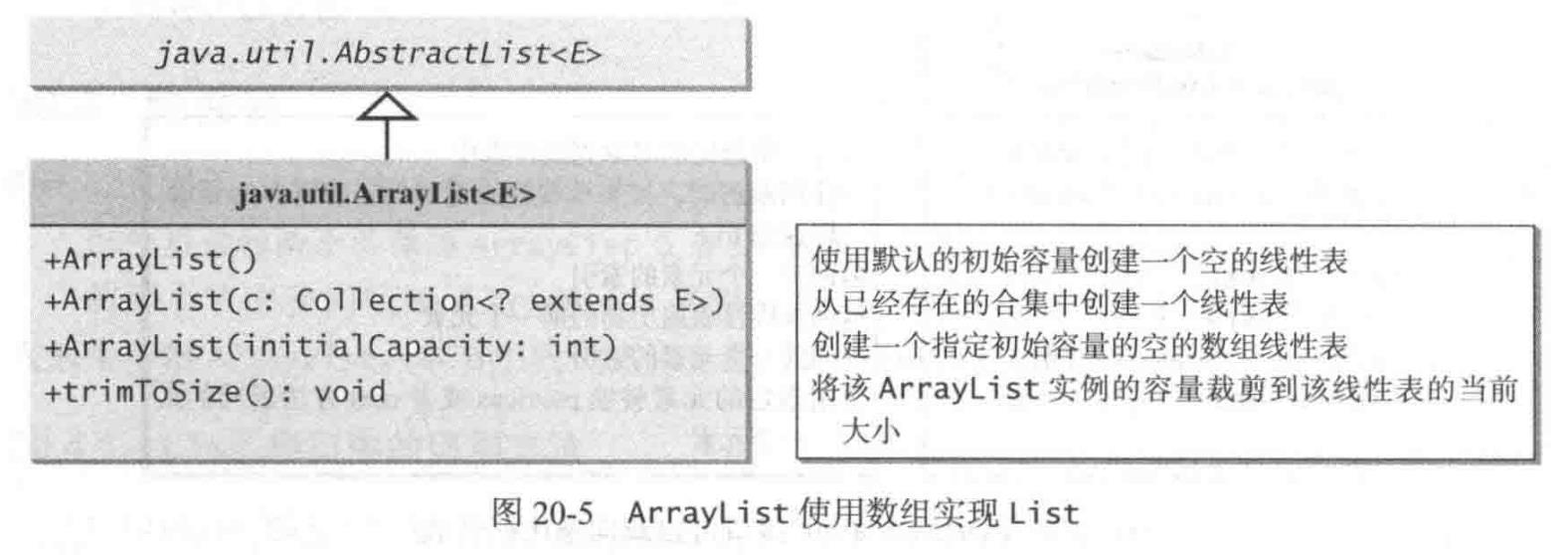
ArrayList不能在表头插入或删除元素。如果需要在表头插入元素,就需要用到LinkedList类。LinkedList类用链表储存元素- LinkedList使用链表来实现List中的基本功能,除此之外,因为链表的优秀特性,它实现了一些在两头删除或者修改的方法。

- 链表可以使用get(i)方法,但是不要用它来遍历链表,这非常低效。应该使用一个迭代器或者foreach方法。(注意:foreach隐含有一个迭代器)
// 非常低效for (int i = 0; i < list.size(); i++){a = get(i);}// 高效for(int i : list){a = i;}
Comparator接口(不是comparable!)
- 我们知道,有一些类实现了
comparable接口,可以通过里面的compareTo方法来比较实现了comparable接口的两个元素。 - 而对于没有实现comparable接口的类,我们可以定义一个比较器(
comparator)来比较不同类的元素。 - 要做到这一点,我们需要定义一个类实现java.util.comparator接口并重写它的compare方法。
// 如果前面的小于后面的,返回一个负值,相等为0,大于为正值。public int compare(T element1, T element2)
- 下面写一个例子来比较两个几何模型,它们可能不是相同的类型,但是它们都有面积,我们就定义通过面积来比较。
// 注意,该方法实现了Serializable接口来进行序列化,在实现comparator接口的地方最好都在后面跟上Serializable接口。public class Geocom● implements Comparator<GeometricObject>, java.io.Serializable{public int compare(GeometricObject o1, GeometricObject o2){double area1 = o1.getArea();double area2 = o2.getArea();if(area1 > area2)return 1;else if(area1 < area2)return 0;else}}
线性表和合集的静态方法
- Collections类包含了许多静态方法来对线性表和合集进行通用操作。
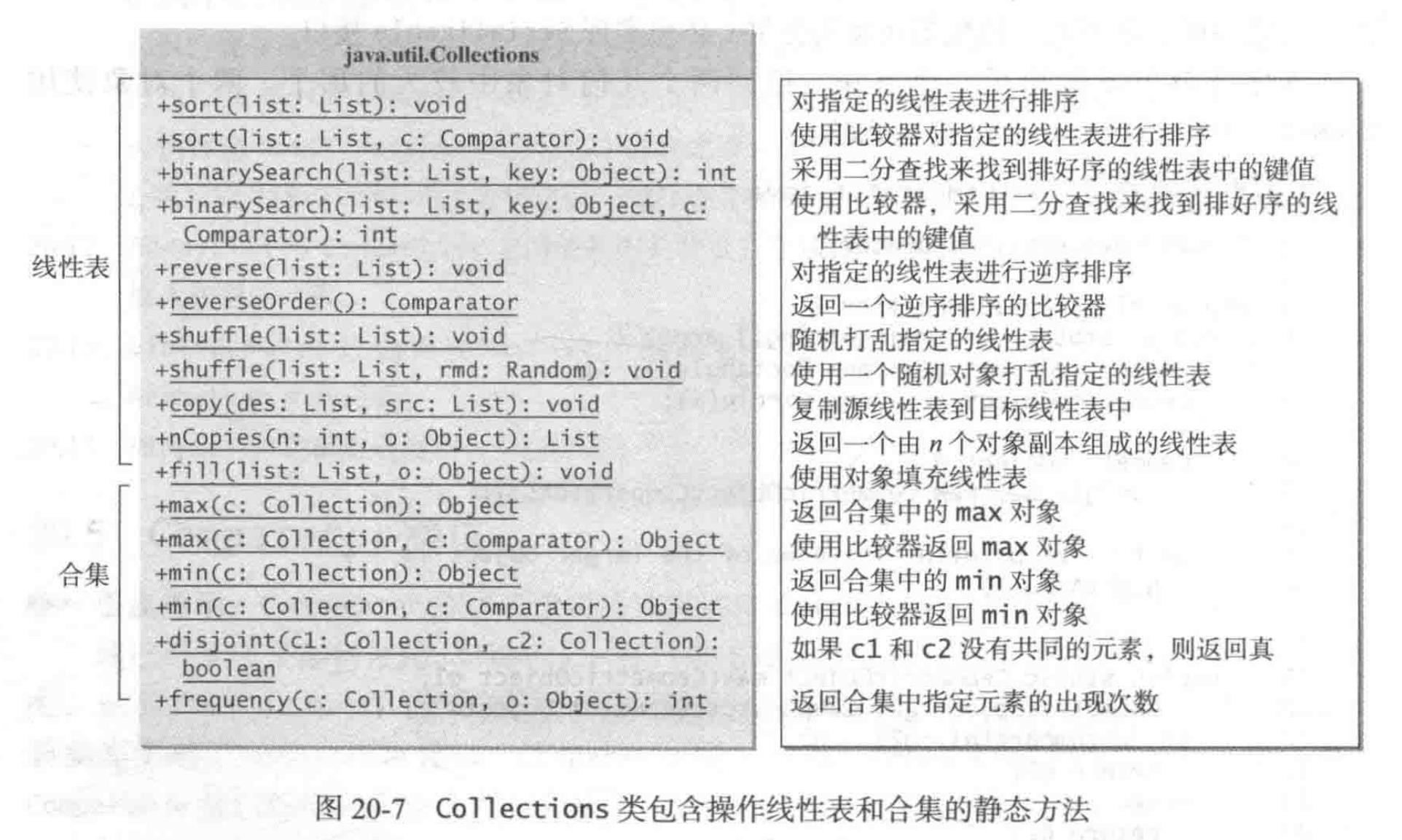
- 注意:这些全是静态方法,因此可以直接使用如
Collections.sort
// 使用Arrays的静态asList方法来方便的创建列表List<String> list = Arrays.asList("red","green","blue");// 使用sort静态方法来排序Collections.sort(list);// 使用重载的sort方法来调用reverseOrder比较器来倒序排序Collections.sort(list, Collections.reverseOrder);
- copy方法中第一个参数是目标列表,第二个才是源列表。目标列表必须大于等于源列表,如果源列表较小,将覆盖目标列表的前面元素,后面不受影响。该复制是浅复制,直接将引用复制过去。
List<String> list1 = Arrays.asList("red","green","blue");List<String> list2 = Arrays.asList("yellow");Collections.copy(list1,list2);// list1 : yellow green blue
向量类Vector和栈类Stack
- Vector和ArrayList一样,继承于AbstractList类,除此之外还有自己的方法。而Stack继承于Vector,拥有更多方法。
- 如果不需要同步,尽量使用ArrayList类,因为vector类非常低效。
栈是一种后进先出的结构。
Vector中的方法
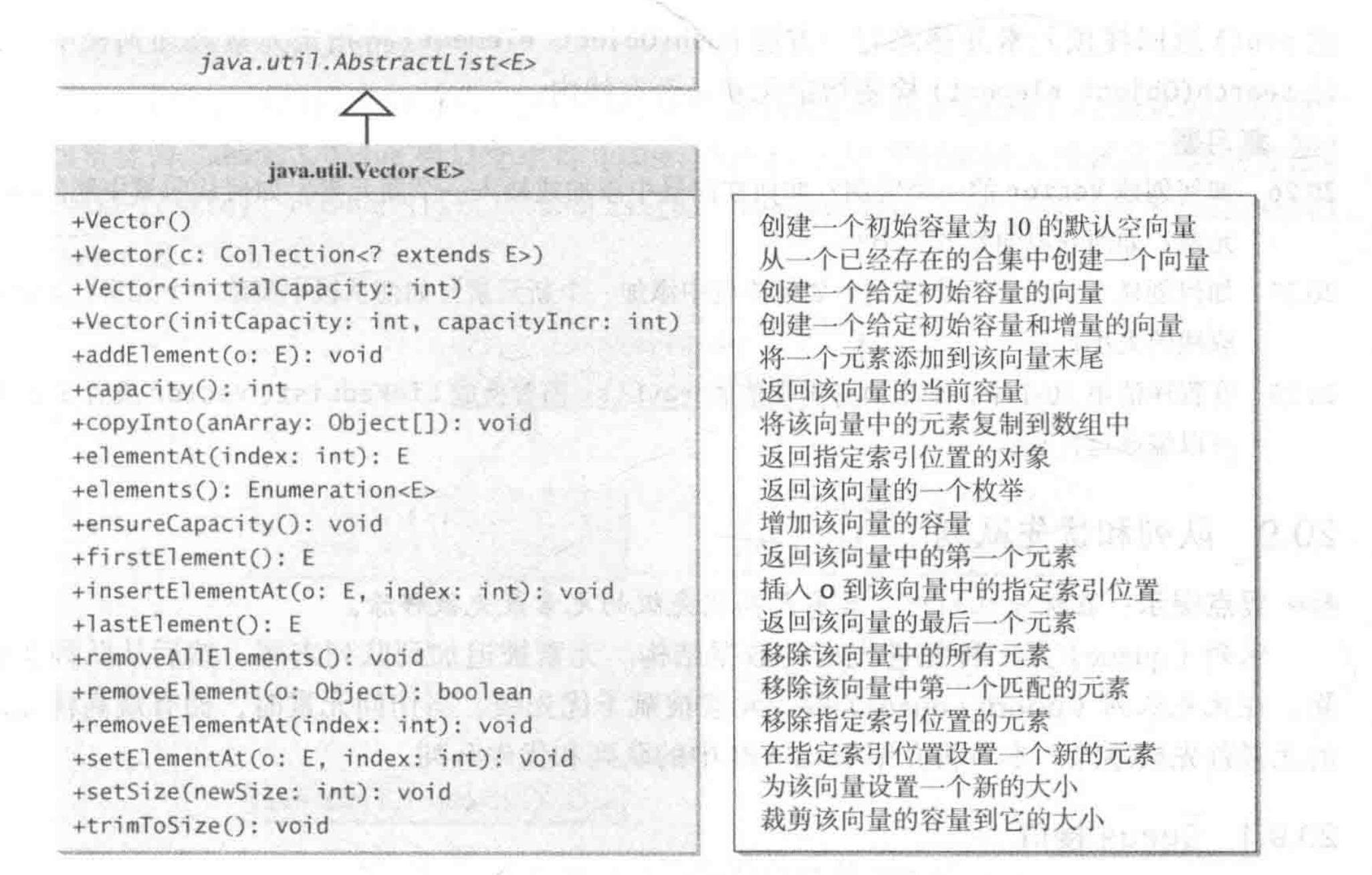
- Stack中的方法
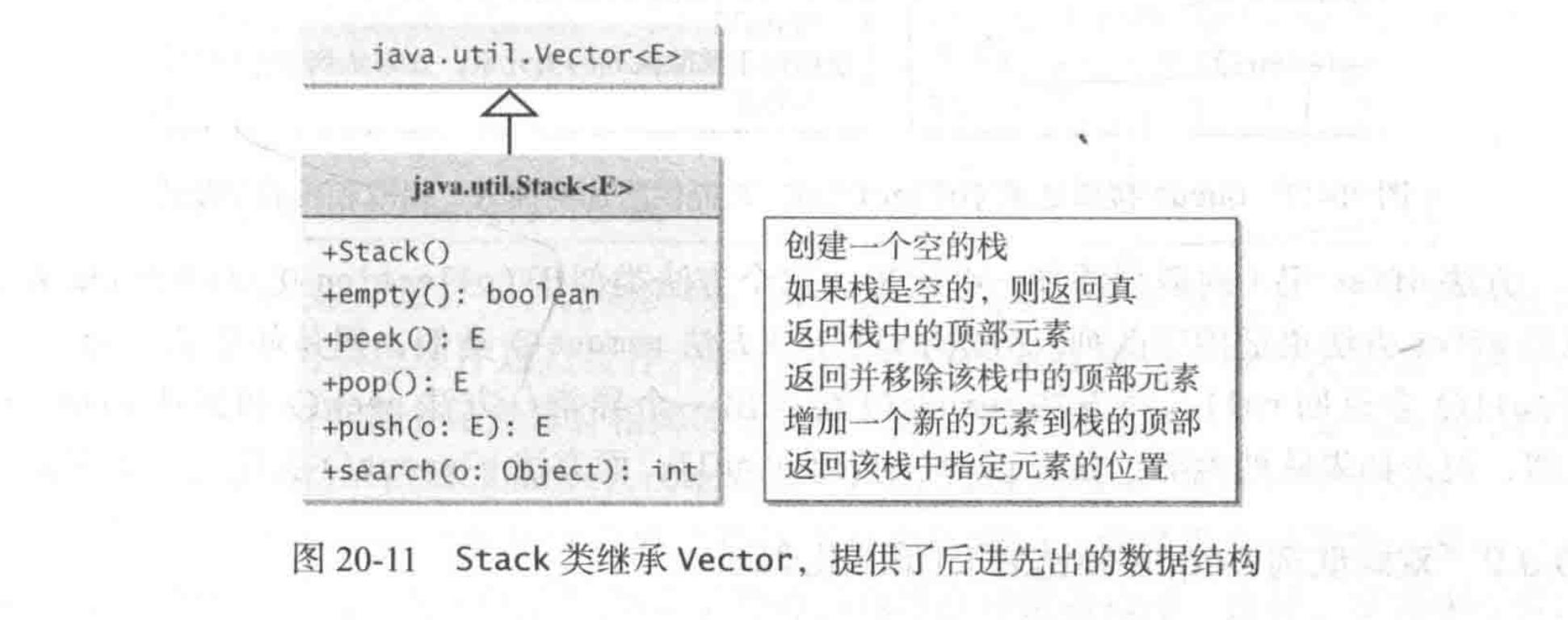
队列Queue和优先队列
- 队列是一种先进先出的数据结构,队列在尾端插入数据,然后在头上删除。优先队列则先删除优先级最高的元素。
- 队列是一个接口,意味着它只是一个类型,具体实现方式可以参考LinkedList,链表很合适。

双端队列接口Deque和链表类LinkedList
- LinkedList实现了Deque接口,而Deque接口又继承于Queue接口,因此可以使用LinkedList创建一个队列。
- Deque(Double-ended queue)接口支持在两端插入和删除元素。相比于Queue增加了addFirst(e)、removeFirst()、addLast()、removeLast()、getFirst()、getLast()方法。

- PriorityQueue类实现了一个优先队列。默认情况下,拥有最小数值的元素被赋予最高优先级,因此最先从队列中删除。如果几个元素的优先级相同,则任意选择一个。
- PriorityQueue(initialCapacity,comparator)中的比较器可以用来指定你想要的顺序。
- 声明一个优先队列,先用默认排序(首字母顺序从小到大),再调用比较器来进行反向排序。
import java.util.*;public class PriorityQueueDemo {public static void main(String[] args) {● PriorityQueue<String> queue1 = new PriorityQueue<>();queue1.offer("Oklahoma");queue1.offer("Indiana");queue1.offer("Georgia");queue1.offer("Texas");System.out.println("Priority queue using Comparable:");while (queue1.size() > 0) {System.out.print(queue1.remove() + " ");}● PriorityQueue<String> queue2 = new PriorityQueue<>(4, Collections.reverseOrder());queue2.offer("Oklahoma");queue2.offer("Indiana");queue2.offer("Georgia");queue2.offer("Texas");System.out.println("\nPriority queue using Comparator:");while (queue2.size() > 0) {System.out.print(queue2.remove() + " ");}}}//输出结果:> Priority queue using Comparable:> Georgia Indiana Oklahoma Texas> Priority queue using Comparator:> Texas Oklahoma Indiana Georgia
第21章 集合(set)和映射表(map)
- 集合和映射表都用来处理无重复的数据。集合只是单个元素,而映射表则每个键值对应了一个值。
集合
- Set接口的三个具体类:HashSet、LinkedHashSet、TreeSet三种集合。
- 所有Set都继承于Collection接口,因此都可以使用removeAll(),retainAll(),addAll()方法。
- 在集合中,不能出现相同的元素,严格的定义就是,不存在元素e1和e2,使得e1.equals(e2)的返回值为true。

HashSet哈希集合 负载系数
- 可以通过无参构造方法来新建HashSet,但是如果要输入参数,就需要定义初始容量和负载系数。默认初始容量为16而负载系数为0.75,它们相乘就是该集合的最大元素个数,因此,默认的集合可以容纳12个元素。
Set<String> hashSet = new HashSet<>();// 等价于Set<String> hashSet = new HashSet<>(16, 0.75);
- 如果两个对象相等,这两个对象的散列码必须一样。两个不相等的对象可能会有相同的散列码,因此应该实现hashCode()方法来避免出现太多这样的情况。
- Java API中大多数类都实现了hashCode方法,Integer类是它的int值,Character类中是这个字符的统一码,String类则更复杂些。
LinedSet、TreeSet
- LinkedSet使用链表来拓展HashSet类,他唯一的特点就是元素进入集合的顺序会被记录下来。但它不能对元素进行排序,就是说进去什么样,以后就是什么样。
- TreeSet可以对元素进行排序,只要将元素输入,它就会默认帮你排好序,同时你可以定义新的比较器来进行你想要的排序。
- 同时TreeSet集成了很多方法,可以用来选择你想要的元素集合。
- TreeSet中的方法:

- 定义一个带比较器的TreeSet
Ser<GeometricObject> set = new TreeSet<>(new GeoComparator);
映射表(Map)
- 可以使用三个具体的类来创建一个映射表:HashMap、LinkedHashMap、TreeMap。
- 映射表按照键值对存储元素。键很像下标,在List中,下标是整数,而在映射表中,键可以为任何对象。和集合一样,映射表不能有重复的键(可以有重复值)。
- Map接口中的方法:


HashMap哈希表、LinkedHashMap、TreeMap
- HashMap是最普通的,它里面的键值对没有顺序。
- LinkedHashMap默认将输入的键值对按输入顺序保存起来,除此之外,你还可以通过在构造方法后面加一个true来按访问顺序创建对象。
// 默认按插入顺序排序Map<String,Integer> linkmap = new LinkedHashMap<>();// 按照访问顺序排序(最后访问的在最后面)Map<String,Integer> linkmap = new LinkedHashMap<>(16, 0.75, true);
- TreeMap自动将存入的键值对按照键来排序。如果使用无参构造方法,则假定类的键实现了Comparable接口。除此之外你也可以自定义比较器,将比较器对象安在构造方法括号里就行。
Map<String, Integer> tmap = new TreeMap<>();Map<String, Integer> tmap = new TreeMap<>(new Comparator);
- 同时,因为TreeMap是已经排好序的,它像TreeSet一样,支持键的查找功能。

- 总结:如果更新映射表时不需要保持映射表中的元素的顺序,就用HashMap。如果需要保持映射表中元素的插入顺序或者访问顺序,就用LinkedHashMap。如果需要使映射表按照键排序,就用TreeMap。
单元素与不可变的合集和映射表
- Collections类中含有静态方法来创建单元素的集合线性表和映射表。以及只读的他们仨。
- 还定义了三个常量,表示空的他们:
EMPTY_SET、EMPTY_LIST、EMPTY_MAP

- 注意:第一行的意思是,返回一个不可变的,只包含了你给的那个对象的单元素集合。而下面的只读视图也是同理,只是他们可以包含更多对象。
第22章 开发高效算法
时间复杂度
- 计算机科学家使用大O符号来表示数量级。我们将时间复杂度为O(n)的算法成为线性算法,它体现为线性的增长率。
- 对于相同的输入大小。我们有最佳情况输入,最差情况输入。其中最差情况输入是重要的,我们可以确定的是我们的算法永远不会比最差情况还慢。
- 平均情况分析是比较理想的,但是相对困难取得,德银对于许多问题而言,要确定各种输入实例的相对概率和分布是相当困难的。
- 因此,分析通常针对最差情况进行。
- 因为
O(logn)=O(log2 n)=O(loga n),所以常量的底可忽略。 - 常用的增长方法趋势图

- 实际上,有时候两个算法可能有相同的时间复杂度,但是仍有优劣之分。如,求最大公约数的方法中,使用暴力破解,时间复杂度为O(n),但是从n往下循环,第一个碰到的肯定是最大公约数,如果从1往上循环,则不一定。并且我们可以从n/2往下循环,也是正确的,虽然时间复杂度都为O(n),但是从大往小的方法显然更好些。
动态编程思想
- 动态编程思想:动态编程是通过解决子问题,然后将子问题的结果结合来获得整个问题的解的过程。
- 这自然的引向递归的解答,然而,使用递归的效率不高,因为子问题互相重叠了。
- 动态编程的关键思想是只解决子问题一次,并将子问题的结果存储以备后用。从而避免了重复的子问题的求解。
- 如,求解斐波那契数列,我们可以通过一个简单的递归解决问题。
public static int fib(int n){if(n == 0)return 0;else if (n <= 2)return 1;elsereturn fib(n - 1) + fib(n - 2);}
- 但是这样每次调用n-1的时候,又会有一个n-2出来,这样就造成了重复调用,我们可以利用动态编程的思想,把每次相加的结果存储在一个数中,从而使最底层的递归不需要到最前面找数据。
public static int fib(int n){int f0 = 0;int f1 = 1;int f2 = 1;if(n == 0)return 0;else if (n <= 2)return 1;for(int i = 3; i < n; i++){f0 = f1;f1 = f2;f2 = f0 + f1;}}
- 同时,我们可以使用尾递归来解决该问题。
public static int fib(int n, int ppre, int pre){if(n <= 1)return ppre;elsereturn fib(int n - 1, int pre, int ppre + pre);}main{fib(5, 1, 1);}
- 尾递归和动态编程的时间复杂度是相同的,都是极为高效的算法。
- 尾递归求斐波那契的解释:
https://blog.csdn.net/mr_listening/article/details/51106535
使用欧几里得算法求解最大公约数。
- 核心思想(尾递归):
用gcd(m, n)表示求m和n的最大公约数。如果m % n=0,那么gcd(m, n)为n。否则,gcd(m, n)就是gcd(n, m % n)。// 时间复杂度为O(logn)public static int gcd(int m, int n){if(m % n == 0)return n;elsereturn gcd(n, m % n);}
for循环的小技巧
- for循环每次循环结束都会判断一次,因此,如果把计算放入判断节,则每次都会计算。可以将计算放在前面完成,然后将结果导入for循环。这样可以减少时间复杂度。
// 计算很多次for(int i = 0; i < (int)math.sqrt(number); i++)// 整个for循环只计算一次int sqrtnum = (int)math.sqrt(number);for(int i = 0; i < sqrtnum; i++)
排序
- 排序算法是学习算法设计和分析的极好例子。
- 本章中默认将整数从小到大排序。
插入排序 InsertionSort O(n^2)
- 插入排序的思想是,重复的将新元素插入一个空的子表,并在每次插入的时候通过计算插入正确的位置,使得子表永远处在排好序的状态。
- 如果插入的元素比之前的都要大,那么直接将它放在表尾。如果它应处的位置在前面,则把应处位置之后的所有元素向后移一位,给它腾出空间。
- 显而易见,如果我们要插入的元素比较小,那么后面的所有元素都要移动,时间复杂度是比较大的。
- 遍历母表中的元素需要一层循环,遍历子表来移动元素又需要一层循环,因此最后的时间复杂度是n^2。
- 算法思路:
1.定义与母数组一样大小的空子数组。
2.遍历a,提取a[i]为插入元素。将插入元素存储在临时变量cur中。
3.从最后一位向前来遍历b(int j = i;;j--),这样在后移的时候不会覆盖后面的元素。
4.如果最后一位的元素比插入元素大(a[j - 1])>cur,则将该元素后移一位。
注意,为什么最后一位的下标为j - 1而不是j呢,我们需要注意到一个细节,就是b中的元素在插入之前,永远比a少一位,因此此时b[i]是空出来的,我们直接把前面的移动到该位置b[j - 1] = b[j],然后向前遍历j--,直到前一位不比cur大为止b[j - 1] > cur。
5.这时所有比插入元素大的元素都后移了一位,而在b[j]的位置上空出来了,那么我们就插入这个空档b[j] = cur;为什么是j?因为j-1小于cur嘛,放到j-1肯定不对,放到j刚刚好。
这样就完成了一个数据的插入,接下来就静等母循环把所有元素依次插入就好了。
public static void main(String[] args) {int[] a = {1, 3, 5, 7, 24, 73, 72, 2};int[] b = new int[8];// b数组的大小要和a一样。int cur = 0;for (int i = 0; i < a.length; i++) {cur = a[i];int j;// importantfor (j = i; j > 0 && b[j - 1] > cur; j--) { // 4b[j] = b[j - 1];}b[j] = cur; // 5}for (int x : b) {System.out.print(x + " ");}}
- 其实,我们真的需要子数组吗?
- 我们可能会觉得,因为要求将数据后移,因此数组后面必须空出来才行,但实际上并非如此。
- 举例
{1,3,5,2}
只有2需要插入排序,插入到3的前面,那么其实2本身就在后面占了一个位置,而前面都是排好序的,5后移只要把2原先的位置占掉就好了,3再去5的位置,因此,在原来的数组里也可以完成排序。
// 注意,这段代码的精妙之处就在于不需要创建子数组。public static void insertionSort(int[] list){for (int i = 0; i < list.length; i++) {int cur = list[i];int j;// 注意,当i == j == 0时,for循环并不会执行,但是j = i仍然会发生,结果就是将第一个插入元素直接插入第一位。而这里并没有新数组,因此就是将list[0]的值赋给list[0]的无意义操作。for (j = i; j > 0 && list[j - 1] > cur; j--) {list[j] = list[j - 1];}list[j] = cur;}for (int x:list) {System.out.print(x + " ");}}public static void main(String[] args) {int[] a = {1, 3, 5, 7, 24, 73, 72, 2};insertionSort(a);}
冒泡排序 BubbleSort O(n^2)
- 顾名思义,冒泡算法就像冒泡泡,它从左往右遍历,每次都比较相邻的两个元素,然后把大的元素交换到右边,因此,如果一个数够大,每次都被交换到右边,它就会寸步不离的跟着我们的i,一路交换到最右边。这样,一次i循环后,最大的元素就冒泡到了最右边。
- 思考一个问题:如果一个数不够大,它会怎么样?
它会一路冒泡,直到遇见比它大的元素,像一块石头挡住它的去路,然后算法会带着石头前进,这个数将停留在石头之前的位置,也就是说,较小的数在一次冒泡后,将会停在原先比他大一位的数的前一个位置,这是一个规律。 - 因此,一次冒泡在宏观看来,就是将最大的数冒泡到了右边,但其实,它里面那些较小的数每个也发生了一次小冒泡。
- 冒泡算法需要两层循环,不像插入排序的两重循环之间还有连续,冒泡循环的第一层循环单纯是用来记次数的,数据有几个就循环几次。而因为越来越多的元素已经冒泡到顶,所以第二层循环每次的次数会变少一个,这点在for的第二个括号中体现。
- 第n次遍历之后,倒数第n个元素成为数组中的第n大数。
- 可以改进的细节:如果一次冒泡发现没有数据变动,那么说明数组已经提前被排序完毕,此时可以直接跳出排序。
public class BubbleSort {public static void main(String[] args) {int[] a = {6, 5, 7, 2, 9, 1, 0};boolean b = true;// 如果上次仍有排序,则继续循环,设置排序序号为falsefor (int j = 0; j < a.length && b; j++) {b = false;//注意每次循环次数减一for (int i = 1; i < a.length - j; i++) {if (a[i - 1] > a[i]) {// 交换元素int temp = a[i];a[i] = a[i - 1];a[i - 1] = temp;// 若本次仍存在冒泡,则继续大循环。// 否则默认终止循环。b = true;}}}for (int x : a) {System.out.print(x + " ");}}}
在最佳情况下,冒泡排序的时间为O(n),即一次全部冒泡成功。
最差情况为每次都要冒泡,为O(n^2)。
归并排序(MergeSort)O(nlogn)
- 归并排序将数组分为两半,对每部分递归地应用归并排序。在两部分都排好序后,对它们进行归并。
- 归并排序就是不断的使用二分。核心思想是递归,在将每一部分分到最小后,在组合的过程中进行排序,最终组合成一个最大的数组。
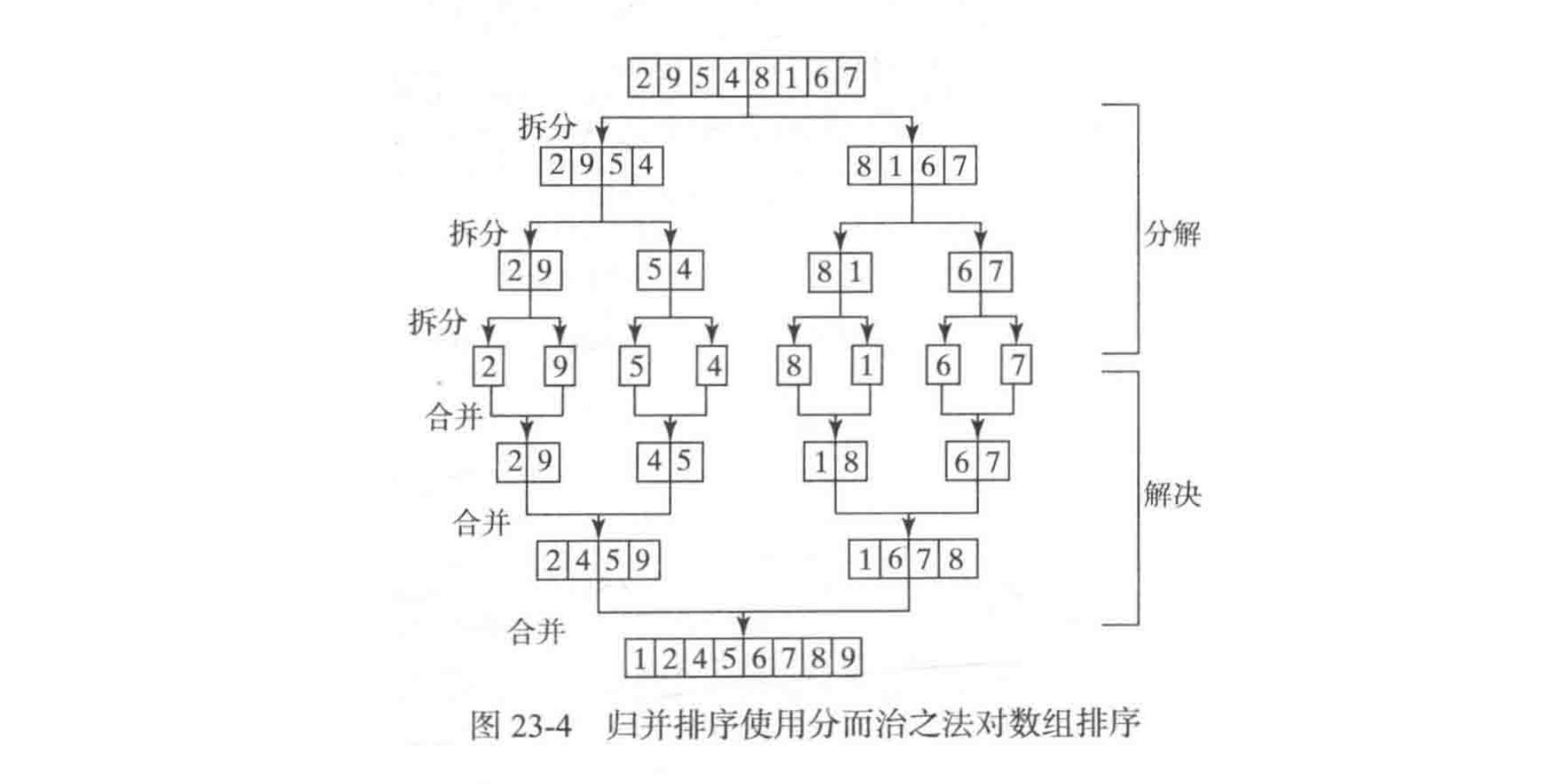
算法思路:
1.通过设计两个方法,一个是主排序方法,一个是单独的合并方法。在主方法中递归的调用分隔方法,直到分隔到底层,然后进行合并。
2.主方法中包含的方法:排序前半部分(递归1),排序后半部分(递归2),将两部分合并成一部分(合并方法)。
3.通过声明两个临时数组来存储数组的前半部分和后半部分。前半部分的数组长度直接通过list.length / 2,但是后面的要用原长度减去前面的长度,而不能直接除以二,否则将会造成数据丢失。如原长度为9,简单的除以二的话是4,两个4的话,最后一个数据就丢失了。
4.在合并方法中,传入三个数组,前半部分,后半部分,总数组。并分别设定三个初始为0的int的下标指向他们。通过while循环重复比较两个部分的数组,并将其中较小的那个元素复制到总数组中,同时该数组和总数组的下标都自增1。
5.当其中一个数组的下标达到尽头时,跳出循环,通过后面的两个while循环将剩下那个数组的剩余元素复制进去就好,因为每次要合并的两个小数组都是排好序的,因此剩下的这些元素直接复制进去是没有问题的。代码:
import java.util.Arrays;public class MergeSort {public static void main(String[] args) {int[] a = {1, 3, 5, 2, 8};mergeSort(a);for (int x : a) {System.out.print(x + " ");}}public static void mergeSort(int[] list) {if (list.length > 1) { // 递归结束条件int[] firstHalf = new int[list.length / 2];int[] secondHalf = new int[list.length - firstHalf.length];// System里的数组复制方法,注意复制后半部分的时候,要从firstHalf.length开始复制(第二个参数),长度是secondHalf.length(最后一个参数)。System.arraycopy(list, 0, firstHalf, 0, firstHalf.length);System.arraycopy(list, firstHalf.length, secondHalf, 0, secondHalf.length);mergeSort(firstHalf);mergeSort(secondHalf);merge(firstHalf, secondHalf, list);}}public static void merge(int[] list1, int[] list2, int[] temp) {int index1 = 0;int index2 = 0;int index3 = 0;// 选取两个数组中较小的数放入最终数组,并在某个数组被读取完后停止。while (index1 < list1.length && index2 < list2.length) {if (list1[index1] < list2[index2])temp[index3++] = list1[index1++];elsetemp[index3++] = list2[index2++];}// 将剩下的数直接复制进最终数组。while (index1 < list1.length) {temp[index3++] = list1[index1++];}while (index2 < list2.length) {temp[index3++] = list2[index2++];}}}
快速排序
- 快速排序在数组中选择一个称为主元的元素将数组分为两部分。使得第一部分的所有元素都小于或等于主元,第二部分的所有元素都大于主元。对第一部分递归的应用快速排序算法,然后对第二部分递归的应用快速排序算法。
- 算法由三个方法组成。一个无参的quickSort方法和带参的重载quickSort算法(递归在此进行),还有一个单独的方法用于返回主元的同时对数组排序。
- 默认将第一个数组选为主元。
package demo2;public class QuickSort {public static void quickSort(int[] list) {quickSort(list, 0, list.length - 1);}public static void quickSort(int[] list, int first, int last) {// 对于每个快速排序,last必须大于first,如果last=-1,就结束递归。if (last > first) {// 返回主元的位置,然后通过主元分割前后两端,并依次进行快速排序。int indexOfPivot = partition(list, first, last);quickSort(list, first, indexOfPivot - 1);quickSort(list, indexOfPivot + 1, last);}}// 返回主元的正确位置,并交换处于不正确位置的元素,使得主元的前面都小于主元,后面都大于主元。public static int partition(int[] list, int first, int last) {int pivot = list[first];int start = first++;int temp = 0;while (first < last) {// 当发现前后两个特例之后,将他们交换。// 如果只有小数列有特例,那么last会一直往前,越过大数列,停在小数列的最后一个位置。// 这种情况大数列本身就是排好序的,因此将小数列中的特例与小数列的最后一位交换。while (first < last && list[first] < pivot)first++;while (first < last && list[last] > pivot)last--;if (first < last) {temp = list[last];list[last] = list[first];list[first] = temp;}}// last的数小于等于pivot时停下。相当于将last放置在小数列的最后一个位置上,即大数列的第一个之前的那个位置。while (list[last] > pivot) {last--;}// 然后将last的数和第一个数(pivot)交换。list[start] = list[last];list[last] = pivot;// 返回last现在所在的位置,也就是主元现在的位置。return last;}public static void main(String[] args) {int[] a = {5, 2, 9, 3, 8, 4, 0, 1, 6, 7};quickSort(a);for (int x : a) {System.out.print(x + " ");}}}
堆排序 (HeapSort) O(nlogn)
- 首先定义堆,这是一棵二叉树。在堆类中以一个ArrayList表示,根节点就是0,左子节点=父节点 * 2 + 1,右子节点 = 父节点 * 2 + 2。
- 堆的父节点一定比任意一个子节点大。因此在每次添加和删除元素后要对堆进行重构。具体为:
- 添加元素
1.添加元素到最后。
2.如果元素大于父节点,将其与父节点互换。
3.直到重新成为堆。 删除根元素
1.将最后一个元素复制到根元素位置,覆盖根元素。
2.将最后一个元素删除。
3.如果根元素小于两个子元素中较大的那个,将它们互换。
4.直到重新成为堆。Heap类
package demo2;public class Heap<E extends Comparable<E>> {private java.util.ArrayList<E> list = new java.util.ArrayList<>();public Heap() {}public Heap(E[] objects) {for (int i = 0; i < objects.length; i++) {add(objects[i]);}}public void add(E newObject) {list.add(newObject);int cur = list.size() - 1;while (cur > 0) {int par = (cur - 1) / 2;if (list.get(par).compareTo(list.get(cur)) < 0) {E temp = list.get(cur);list.set(cur, list.get(par));list.set(par, temp);} elsebreak;// change par to cur.cur = par;}}public E remove() {if (list.size() == 0) return null;E removeObject = list.get(0);list.set(0, list.get(list.size() - 1));list.remove(list.size() - 1);int cur = 0;while (cur < list.size()) {int son1 = cur * 2 + 1;int son2 = cur * 2 + 2;// 左子节点要严格小于list才不会越界if (son1 >= list.size()) break;// 找到两个子节点中比较大的int max = son1;if (son2 < list.size()) {if (list.get(son1).compareTo(list.get(son2)) > 0)max = son1;elsemax = son2;}if (list.get(cur).compareTo(list.get(max)) < 0) {E temp = list.get(cur);list.set(cur, list.get(max));list.set(max, temp);cur = max;} elsebreak;}return removeObject;}public int getSize() {return list.size();}}
- HeapSort类
package demo2;public class HeapSort {public static <E extends Comparable<E>> void heapSort(E[] list) {// 通过list新建堆Heap<E> a = new Heap<>(list);// 注意,remove出来的是堆中最大的元素,因此要从后面开始遍历。for (int i = list.length - 1; i >= 0; i--) {list[i] = a.remove();}}public static void main(String[] args) {Integer[] a = {5, 2, 9, 3, 8, 4, 0, 1, 6, 7};heapSort(a);for (Integer x : a) {System.out.print(x + " ");}}}
第24章 实现线性表、栈、队列和优先队列
线性表的通用特性
- 实现线性表的方法有两种,一种是使用数组,另外一种则是使用链表。两种线性表的实现方法不同,但是操作是相同的。
- 因此我们可以定义一个接口
MyList来声明相同的方法,然后让ArrayList和LinkedList接入接口后用不同的方式实现方法。 - 在这之间实现了一个抽象类
MyAbstractList来添加size属性。 - 注意:
MyAbstractList中的size被声明为protected,protected一般很少使用,但在这里很合适,因为它的子类可以访问大小,而其他包中的非子类并不能访问它。作为一个常用规则,可以将抽象类中的数据域声明为被保护的。


数组线性表

- 数组线性表的实现方式很简单,使用一个
E[]数组来存储,存储的是引用。 - 如果超过数组长度,则将数组变长一倍,然后将旧数组复制进来。
- 如果要在指定位置插入元素,先检查数组会不会越界,然后将所有后面的元素后移一位。
- 如果要删除元素,则将后面所有元素前移一位。
栈和队列
- 栈用数组实现,队列用链表实现。
- 栈在栈头添加和删除。
- 队列元素在队列尾追加,在队列头删除。
优先队列
- 优先队列用堆实现。
第25章 二叉搜索树
- 树的遍历(包括非递归方式实现遍历):https://www.cnblogs.com/songwenjie/p/8955856.html
第26章 AVL树 平衡二叉搜索树
第27章 散列
- 使用散列将耗费O(1)的时间来查找、插入以及删除一个元素。
散列码
反射
廖雪峰的官方网站:https://www.liaoxuefeng.com/wiki/1252599548343744/1264799402020448
- 由于JVM为每个加载的
class创建了对应的Class实例,并在实例中保存了该class的所有信息,包括类名、包名、父类、实现的接口、所有方法、字段等,因此,如果获取了某个Class实例,我们就可以通过这个Class实例获取到该实例对应的class的所有信息。 - 因为Class实例在JVM中是唯一的不管用什么方法创建实例,最后得到的都是同一个Class实例。
第30章 多线程和并行程序设计
创建单个线程以及Thread类的一些方法

- 任务必须从线程运行,创建一个任务类必须实现Runnable接口并重写它的run()方法。
然后通过新建一个以任务为参数的Thread对象来新建线程。
TaskClass task = new TaskClass();// TaskClass类实现了Runnable接口Thread thread = new Thread(task);// 通过TaskClass创建一个线程thread.start();// 启动它
- 由于Thread类实际上就实现了Runnable接口,所以直接用一个类继承Thread类来间接实现Runnable接口也是可以的,别忘了重写run()方法。
MyThread mythread = new MyThread();// Myshread类继承了Thread类mythread.start();// 直接启动子类就好
Thread.yield()方法用来暂时将时间让给其他线程。Thread.sleep()方法可以让线程暂时休眠几毫秒。注意:使用Thread.sleep()方法时,必须捕获InteruptedException。所以要将代码放到tryCatch块中。如果一个循环中调用了sleep方法,那就要将整个循环放入catch块中。Thread.join()方法可以让这个线程插队,其他线程会等待调用join的线程跑完再开始工作。setPriority()和getPriority()可以查看与设置优先级(0-10),优先级较高的线程会优先运行,如果一个高优先级的线程一直运行,会发生资源匮乏,因此,高优先级的线程必须定时的调用sleep()或yield()方法来让出资源。
- 可以使用匿名内部类来简洁地创建一个线程:
new Thread(new Runnable(){}).start();// 填充run()方法new Thread(new Runnable(){@Overridepublic void run(){System.out.println("nihao");}}).start();// 可以使用Lambda表达式进一步简化,将new Runnable(){} 变成()-> {}// 并且不用写run()的方法头!new Thread(()->{System.out.println("nihao");}).start();
线程池 Executor接口以及Executors方法
newFixedThreadPool(int n)用来创建一个最多运行n线程的线程池。如果一个线程60s没有被调用,则杀死他。newCachedThreadPool()创建一个灵活的线程池。

ExecutorService executor = Executors.newFixedThreadPool(3);// 如果设置为1,那么三个线程将串行执行。// 如果是newCachedThreadPool(),所有任务都并发执行。executor.execute(new PrintChar('a', 100));// +execute(Runnable object):voidexecutor.execute(new PrintChar('b', 100));executor.execute(new PrintNum(100));executor.shutdown();
线程同步 synchronized关键字
- 锁是一种实现资源排他的机制,对于实例方法,就给调用该方法的对象加锁,对于静态方法,就给类加锁。在解锁之前,其他想要染指该对象(类)的线程只能等待。
- 1.直接在类声明前或者方法声明上(返回值前)加上synchronized关键字,就可以把整个设置为同步的。
- 2.通过同步语句块,可以实现更精细的操作。
synchronized(expr){ // expr必须是一个对象的引用//...}synchronized(account){account.toString();}将synchronized后面的括号中填上this,就可以锁定当前对象或者当前类。
显式加锁 Lock接口

private static Lock lock = new ReentrantLock();lock.lock();try{}catch{}finally{lock.unlock();}尽量把锁的释放放在finally里,这样可以确保锁被释放。
- 我们不光需要线程之间的互斥,我们还希望线程能在我们需要的时候互相协作。通过Lock.newCondition()方法,可以返回一个Condition类,它含有一些控制锁的方法。

例如,我们想通过两个线程,一个提款,另一个存款,在单独行动的时候另一个都不能打扰,而在某些情况下又想把锁移交过去,比如提款余额不足的时候就调用存款线程,先存进去,然后再调用取款线程,尝试取款。

代码实现
private static Lock lock = new ReentrantLock();private static Condition newDeposit = lock.newCondition();


- 一旦对线程调用条件上的await(),线程就进入等待状态,如果忘记对线程调用signal()或者signalAll(),那么线程就将永远等待下去。
监视器
- 遗留的旧版方法,在synchronized方法块中对对象使用wait(),notify(),notifyAll()方法。必须在代码块中调用,否则就会出现,IllegalMonitorStateException异常。

信号量
- 信号量确保同一时间只有n个线程访问资源。(锁是确保1个)


死锁
- 如果两个线程都各自占有一把锁,又都在等待对方释放锁,就会形成死锁。

- 通过资源排序的方法可以避免死锁,如线程2必须先获得object1的锁才能进行,那么他就不会占有object2的锁不放,这样就可以等待Thread1使用完后再顺利的进行Thread2了。
线程状态

同步合集

- 这些同步包装类都是线程安全的,但是迭代器有快速失效的特性,当使用迭代器的时候进行修改,就会报错。因此不能边迭代边修改,更加地,应该把迭代器用同步块包装起来。

并行编程
https://www.cnblogs.com/cjsblog/p/9078341.html


